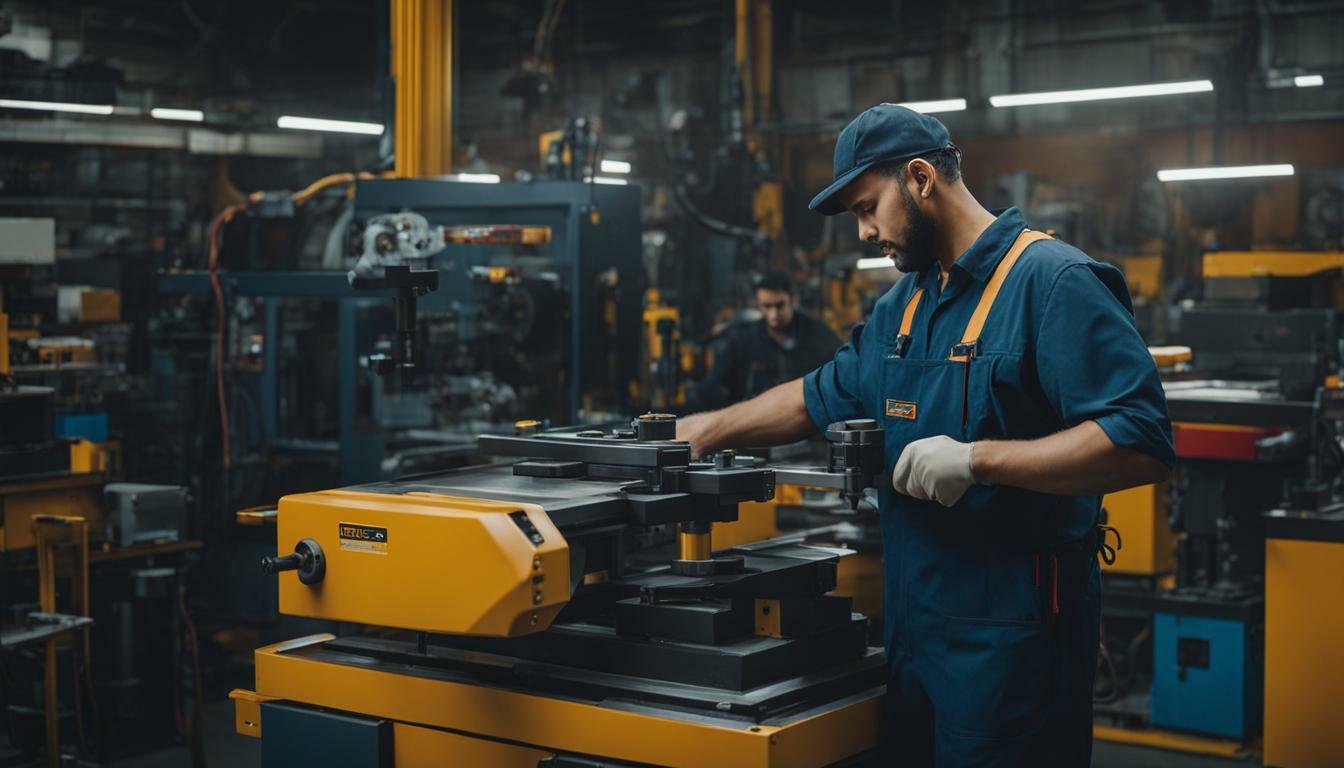Servicing a CNC machine is crucial for maintaining its performance and preventing unexpected downtime. Regular maintenance helps ensure the machine produces quality products and has a longer lifespan. However, many individuals may find the process of servicing a CNC machine overwhelming.
That’s why we have created this simple guide to help you understand the importance of CNC machine maintenance and provide you with practical tips to effectively service your machine. Whether you are a beginner or an experienced operator, this guide will equip you with the knowledge and tools to keep your CNC machine running smoothly.
- Regular maintenance is crucial for a CNC machine’s performance and longevity.
- Common challenges in CNC machine maintenance include time constraints, excessive vibration, overheating, software issues, and power supply problems.
- Maintaining thorough maintenance records, providing adequate employee training, keeping a clean environment, and monitoring machine operations are essential for effective servicing.
- Creating standard operating procedures and maintenance checklists can streamline the maintenance process.
- Following a structured maintenance schedule, including daily, weekly, monthly, and annual tasks, ensures optimal CNC machine performance.
The Importance of CNC Machine Maintenance
Proper maintenance of a CNC machine is vital to ensure its longevity and prevent costly repairs. Regular maintenance not only improves the performance and accuracy of the machine but also helps avoid unexpected downtime, which can significantly impact production schedules and profitability. By implementing preventive maintenance strategies, you can minimize the risk of breakdowns and maximize the efficiency of your CNC machine.
One of the key benefits of preventive maintenance is the ability to identify and address potential issues before they escalate. By conducting routine inspections and adhering to a maintenance checklist, you can catch early signs of wear and tear, loose components, or software glitches. This proactive approach allows you to make necessary repairs or adjustments promptly, preventing small problems from turning into major breakdowns that require costly repairs or replacements.
Creating a maintenance checklist is essential to ensure that no critical maintenance tasks are overlooked. This checklist should include tasks such as lubricating machine components, cleaning the machine and its peripherals, inspecting coolant levels, and checking for any abnormalities. By following a structured maintenance plan and adhering to the checklist, you can ensure that all necessary maintenance tasks are completed on time and that your CNC machine operates at its optimal level.
| Task | Frequency |
|---|---|
| Inspect lubricant and coolant levels | Daily |
| Clean the machine and peripherals | Daily |
| Check for abnormalities | Daily |
| Inspect coolant tank and tool heads | Monthly |
| Replace air filters | Monthly |
| Change lubricant | Annual |
By following a comprehensive maintenance schedule and checklist, you can ensure that your CNC machine remains in top shape and continues to deliver optimal performance. Additionally, maintaining thorough records of all maintenance activities is crucial. These records provide a valuable reference for tracking maintenance tasks, identifying recurring issues, and ensuring compliance with the manufacturer’s recommendations. They also serve as essential documentation for warranty claims and audits.
Remember, preventive maintenance is an investment in the long-term performance and profitability of your CNC machine. By prioritizing regular maintenance, providing adequate training to your employees, maintaining a clean environment, and monitoring machine operations, you can extend the lifespan of your machine, minimize downtime, and maximize productivity.
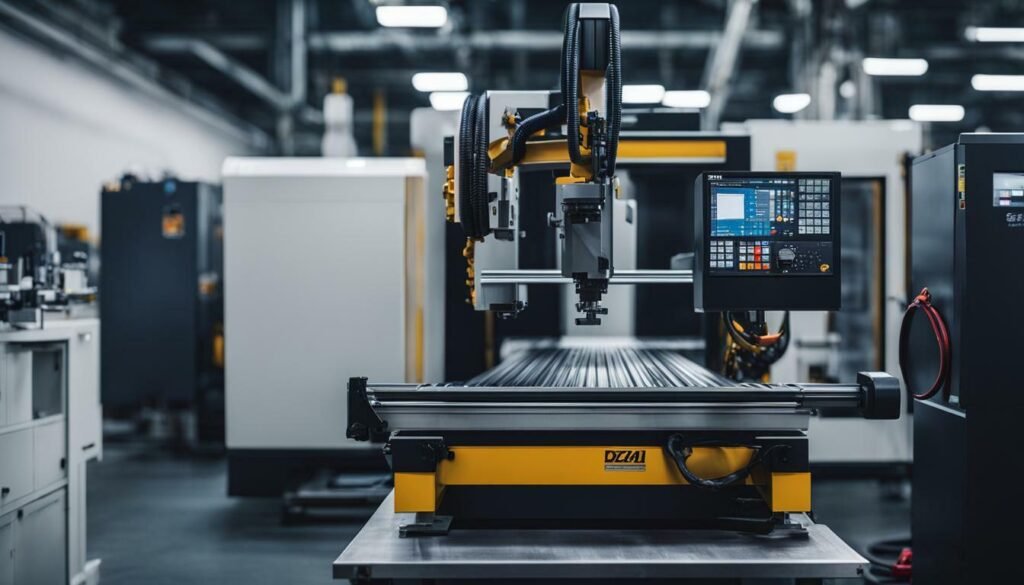
“Proper maintenance is the key to unlocking the full potential of your CNC machine.”
Creating a Maintenance Schedule
Developing a maintenance schedule and adhering to it is crucial for the optimal performance of your CNC machine. Regular maintenance not only helps prevent unexpected downtime but also ensures that your machine produces high-quality products and has a longer lifespan. By following a structured maintenance plan, you can address potential issues before they escalate and keep your CNC machine running smoothly.
When creating a maintenance schedule for your CNC machine, it is important to consider the frequency of maintenance tasks. Daily, weekly, monthly, and annual checklists should be established to address various maintenance needs. These checklists can include tasks such as inspecting lubricant and coolant levels, cleaning the machine, servicing peripherals, and running software simulations.
To give you a better understanding of what your maintenance schedule might look like, here’s a breakdown of the tasks that can be included:
| Task | Frequency |
|---|---|
| Inspect lubricant and coolant levels | Daily |
| Clean the machine | Daily |
| Check for any anomalies | Daily |
| Clean the machine shop | Weekly |
| Check for leaks | Weekly |
| Lubricate machine parts | Weekly |
| Clean the coolant tank | Monthly |
| Inspect tool heads | Monthly |
| Replace air filters | Monthly |
| Inspect coolant cylinder tanks | Annual |
| Change lubricant | Annual |
| Run software simulations | Annual |
By following these maintenance schedules and conducting regular inspections, you can be proactive in identifying and addressing any issues that may arise with your CNC machine. With proper maintenance, your machine will continue to perform optimally, ensuring efficient production and minimizing costly downtime.
Thorough Maintenance Records
Keeping detailed maintenance records is essential for tracking the history and performance of your CNC machine. By maintaining accurate documentation, you can ensure that all maintenance tasks are carried out on time and in accordance with manufacturer recommendations.
A maintenance log allows you to easily reference past service dates, repairs, and any recurring issues that may require attention. This information can help identify patterns or trends that may be affecting the machine’s performance. Additionally, detailed records can be vital in warranty claims or when seeking technical support from the manufacturer.
When creating maintenance records, be sure to include the date of each service, the specific tasks performed, and any parts or consumables used. It’s also helpful to note the condition of the machine before and after servicing. By capturing this information, you can better understand the machine’s overall health and address any potential issues proactively.
| Date | Service Tasks | Parts/Consumables Used | Machine Condition |
|---|---|---|---|
| 01/15/2022 | Performed routine maintenance checklist | Replaced coolant filter | Machine in good condition, no abnormal noises |
| 02/05/2022 | Inspected tool heads and replaced worn-out tools | N/A | One tool head required adjustment, all others in good condition |
| 03/22/2022 | Cleaned coolant tank and refilled with fresh coolant | Coolant filter, coolant | Excessive debris in coolant tank, coolant level low |
Remember to keep your maintenance records organized and easily accessible. Whether you prefer a digital database or a physical logbook, having a well-maintained record-keeping system ensures that you can refer back to historical data whenever needed, enabling you to make informed decisions about your CNC machine’s service requirements.
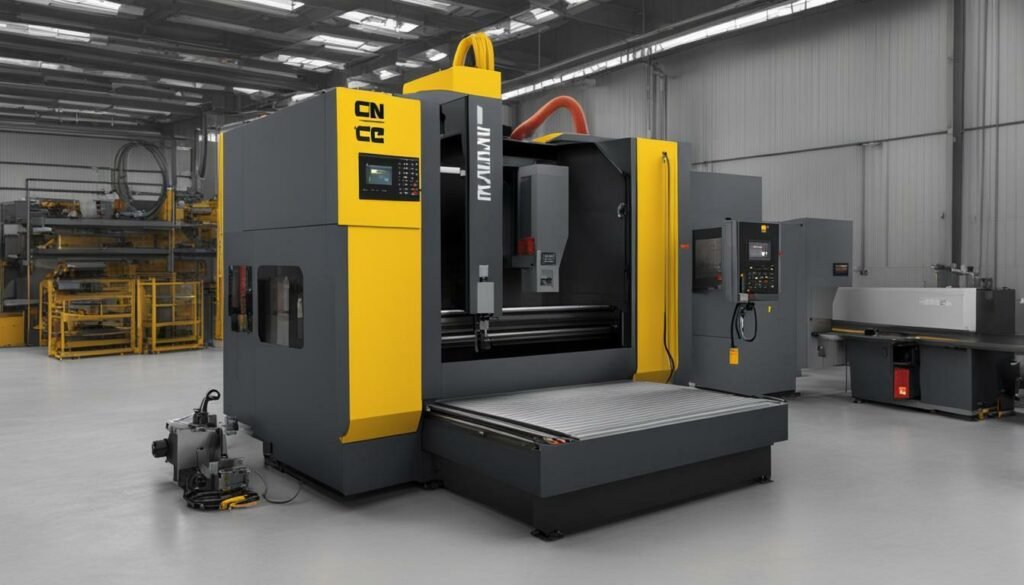
Regularly updated and detailed maintenance records are crucial for keeping your CNC machine in optimal condition and minimizing downtime. By tracking the maintenance history and performance of your machine, you ensure that it receives proper care and attention. Furthermore, these records can be valuable when troubleshooting issues, identifying trends, and planning future maintenance tasks.
Employee Training and Machine Safety
Providing comprehensive training to your employees is crucial to ensure safe and effective CNC machine maintenance. Proper training empowers your employees to understand the intricacies of CNC machines, identify potential issues, and perform routine maintenance tasks. This not only enhances the lifespan of the machine but also improves overall work efficiency and reduces the risk of accidents. Training sessions should cover important topics such as machine safety protocols, basic troubleshooting techniques, and proper handling of machine tools. Employees should also be trained on the specific maintenance tasks outlined in the maintenance checklist to ensure they are performed correctly. This includes tasks such as lubricating components, cleaning the machine, and servicing peripherals. To facilitate effective training, consider utilizing visual aids such as instructional videos, diagrams, and interactive simulations. These resources can help employees understand complex concepts and processes more easily. Additionally, hands-on training sessions where employees can practice maintenance tasks under supervision are highly beneficial. Creating a culture of safety is equally important. Encourage employees to report any abnormalities or concerns they observe during machine operation. Regular reminders about safety procedures and tips for preventing accidents should also be emphasized. By prioritizing employee training and machine safety, you can ensure that your CNC machine operates at its best while keeping your workforce safe.
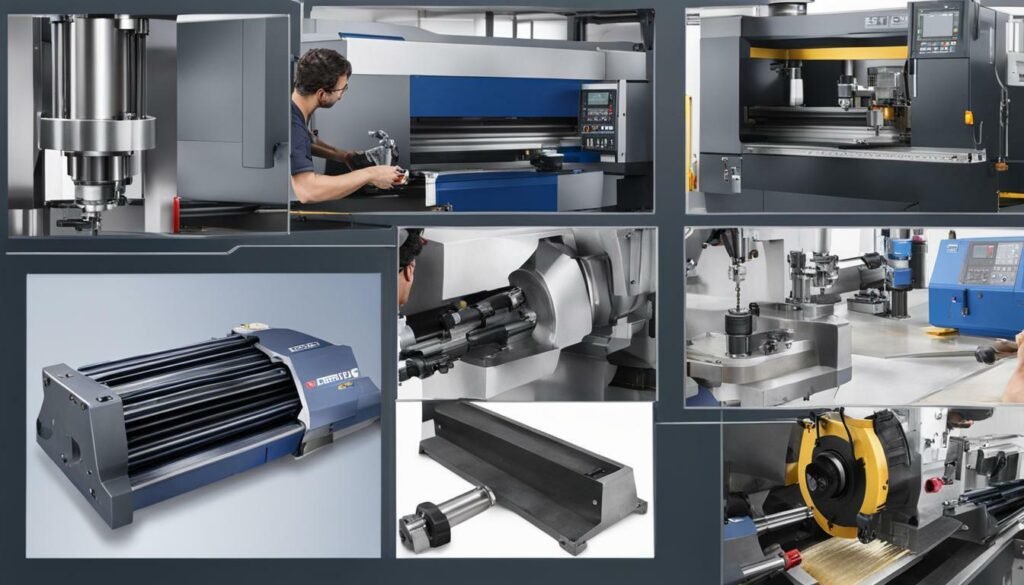
Common Challenges in CNC Machine Maintenance
While CNC machine maintenance is essential, it comes with its fair share of challenges. Time constraints are a common obstacle, as maintenance tasks may require the machine to be temporarily shut down, impacting production schedules. However, proper scheduling and planning can help minimize these disruptions. Excessive machine vibration is another challenge that can affect CNC machine performance. This can result from various factors, including misalignment, worn-out parts, or improper machining processes. Regular maintenance, including inspecting and replacing worn-out components, can help mitigate excessive vibration and maintain optimal machine performance. Overheating is another issue that can arise during CNC machine operation. Excessive heat can impact the accuracy and reliability of the machine, leading to potential errors and decreased productivity. Regularly cleaning the machine and ensuring proper cooling system function can help prevent overheating and maintain consistent performance. Software issues are also common challenges in CNC machine maintenance. Regularly updating software and performing routine checks for any glitches or bugs can help ensure smooth machine operation. Additionally, having a backup system in place can be beneficial to minimize downtime in case of software failures. Lastly, power supply issues can impact CNC machine performance and reliability. Ensuring a stable power supply, proper grounding, and adequate voltage levels are important factors in preventing power-related problems. Regularly inspecting power connections and addressing any issues promptly can help maintain uninterrupted machine operation. By being aware of these common challenges and implementing proactive maintenance strategies, you can keep your CNC machine in optimal condition and maximize its productivity.
Maintenance Checklist for CNC Machine
To ensure proper CNC machine maintenance, following a structured maintenance checklist is crucial. This checklist should include daily, weekly, monthly, and annual tasks to address various aspects of machine upkeep. Here’s a general outline of the tasks that can be included:
- Inspect lubricant and coolant levels
- Clean the machine and remove any debris
- Check for any anomalies or unusual sounds during machine operation
- Clean the coolant tank and replace coolant if necessary
- Inspect tool heads for wear or damage
- Check for any leaks or loose connections
- Lubricate machine parts as per manufacturer recommendations
- Replace air filters periodically
- Inspect coolant cylinder tanks for any signs of wear
- Change lubricants and filters as recommended by the manufacturer
- Perform software simulations to ensure accurate performance
Following this maintenance checklist diligently will help identify potential issues early on and prevent major breakdowns. Regular maintenance not only extends the lifespan of your CNC machine but also ensures consistent and high-quality performance.
| Maintenance Frequency | Performed Tasks |
|---|---|
| Daily |
|
| Weekly |
|
| Monthly |
|
| Annual |
|
Following a proper maintenance schedule and checklist will help keep your CNC machine running smoothly, reduce the risk of unexpected downtime, and ensure optimal performance and productivity in your machining operations.
Maintaining a Clean Environment
A clean environment is essential for optimal CNC machine performance and preventing potential issues. Dust, debris, and contaminants can negatively affect the machine’s precision and cause wear and tear on its components. Regular cleaning and maintenance of the CNC machine and its surroundings can help extend its lifespan and ensure consistent, high-quality results.
To maintain a clean environment, follow these tips:
- Regularly remove dust and debris from the machine’s exterior, using a soft brush or cloth. Pay close attention to areas such as the control panel, spindle, and tool holders.
- Keep the machine’s workspace tidy and organized. Avoid clutter or excessive materials that can obstruct the machine or pose safety risks.
- Implement a regular cleaning schedule for the machine’s coolant system. Flush and clean the coolant tank, filters, and lines as recommended by the manufacturer.
- Use appropriate cleaning agents and lubricants that are compatible with the CNC machine’s components. Avoid using harsh chemicals that can damage the machine.
Maintaining a clean environment also includes proper waste management. Dispose of any waste materials, such as coolant, lubricants, or metal shavings, according to local regulations and industry best practices.
By keeping your CNC machine and its surroundings clean, you can minimize the risk of contamination, ensure smooth operation, and optimize performance for reliable and efficient production.
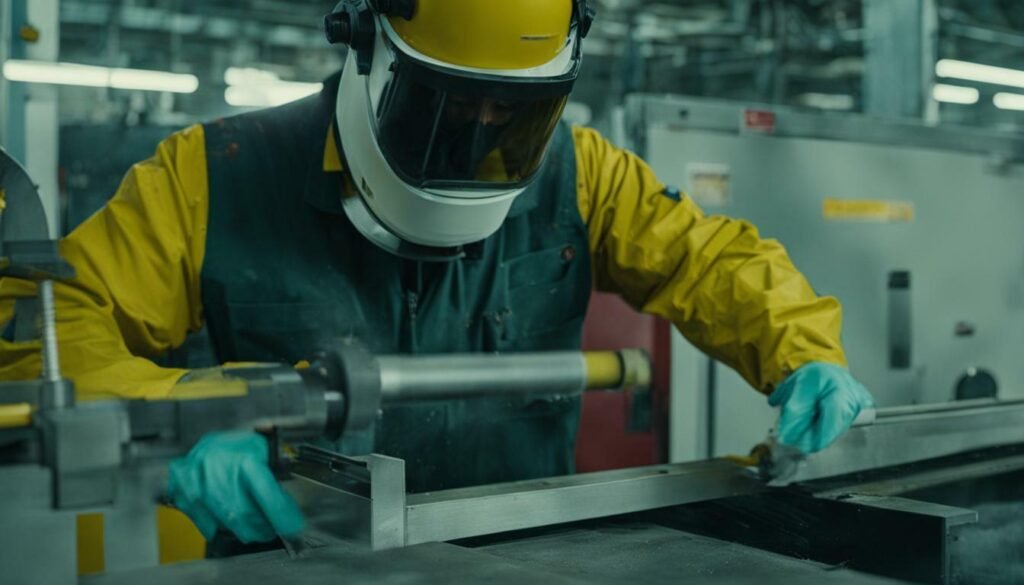
Regularly monitoring your CNC machine’s operations is crucial for identifying and addressing potential issues promptly. By staying vigilant and observing the machine’s performance, you can catch any abnormalities early on, preventing them from escalating into major problems that can lead to downtime and costly repairs.
During your monitoring process, pay close attention to any unexpected vibrations or noises coming from the machine. Excessive vibration could indicate a problem with the machine’s components or tooling, while strange noises could be a sign of worn-out parts or improper lubrication. It’s important to address these issues promptly to prevent further damage and ensure optimal performance.
Another aspect to monitor is the machine’s temperature. Overheating can be detrimental to CNC machines, causing damage to sensitive electronic components and affecting their overall performance. Keep an eye on temperature readings and take action if they exceed recommended levels. This could involve inspecting the cooling system, cleaning the air vents, and ensuring proper ventilation in the machine’s vicinity.
Software-related issues can also impact CNC machine operations, so it’s essential to monitor any error messages or system malfunctions. Be proactive in keeping your software up to date and address any compatibility issues that may arise. Regularly backing up your software settings and configurations is also recommended to prevent data loss and ensure a quick recovery in case of system failures.
| Monitoring Tips: | Frequency |
|---|---|
| Check for abnormal vibrations or noises | Daily |
| Monitor machine temperature | Daily |
| Stay updated with software errors | Ongoing |
| Regularly backup software settings | Monthly |
Remember, regular monitoring of your CNC machine’s operations allows you to catch any potential issues before they worsen, minimizing downtime and maximizing productivity. By incorporating these monitoring practices into your maintenance routine, you can ensure that your CNC machine continues to perform at its best.
Standard Operating Procedures and Maintenance Checklists
Establishing standard operating procedures and maintenance checklists can streamline CNC machine servicing and ensure all necessary tasks are performed. By having a standardized approach, you can enhance the efficiency of your maintenance processes and minimize the risk of overlooking crucial maintenance procedures.
One of the key benefits of having standard operating procedures (SOPs) is that they provide clear instructions for the steps involved in CNC machine maintenance. These SOPs can include detailed guidelines on specific tasks, such as lubricating components, cleaning the machine, and servicing peripherals. By following these procedures consistently, you can maintain the optimal functioning of your CNC machine.
Maintenance checklists are another valuable tool for CNC machine servicing. These checklists outline the tasks that need to be performed daily, weekly, monthly, and annually to keep the machine in peak condition. They can serve as a reminder of critical maintenance activities, such as inspecting lubricant and coolant levels, cleaning the machine, checking for any anomalies, and replacing worn-out parts.
| Maintenance Checklist | Frequency |
|---|---|
| Inspect lubricant and coolant levels | Daily |
| Clean the machine | Daily |
| Check for anomalies (vibration, overheating, etc.) | Daily |
| Clean the machine shop | Weekly |
| Check for leaks | Weekly |
| Lubricate machine parts | Weekly |
| Clean the coolant tank | Monthly |
| Inspect tool heads | Monthly |
| Replace air filters | Monthly |
| Inspect coolant cylinder tanks | Annually |
| Change lubricant | Annually |
| Run software simulations | Annually |
By adhering to these maintenance checklists, you can ensure that essential tasks are performed at regular intervals, promoting optimal performance and extending the lifespan of your CNC machine. Proper maintenance can also help minimize the risk of unexpected breakdowns, reducing costly downtime and maximizing productivity.
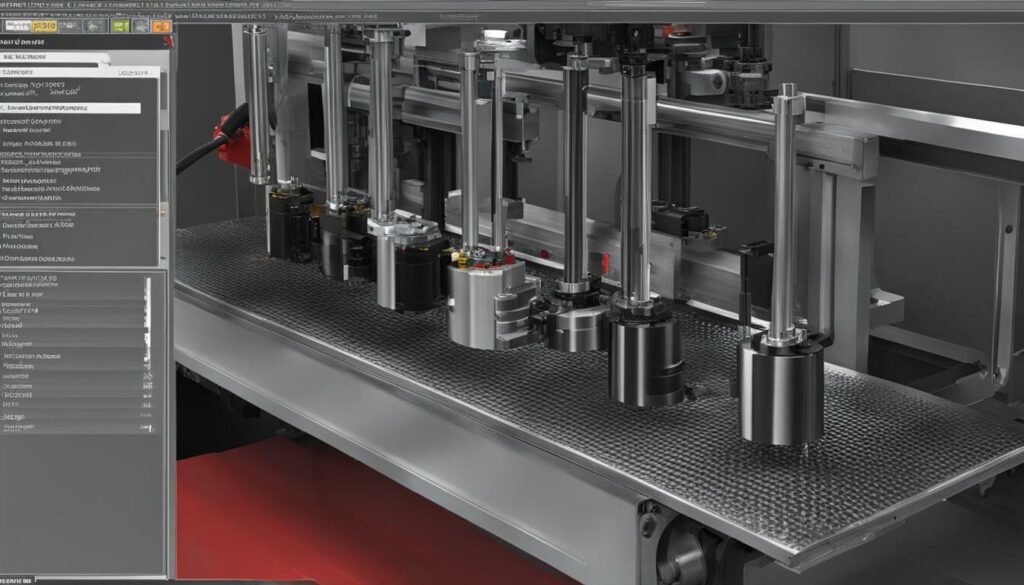
Remember, a well-maintained CNC machine is essential for consistent performance and product quality. By implementing standard operating procedures and maintenance checklists, you can stay on top of routine maintenance tasks and keep your CNC machine running smoothly.
Conclusion
Regular maintenance is essential for maximizing the performance and lifespan of your CNC machine. By following a proper maintenance schedule, you can prevent unexpected downtime and ensure that your machine consistently produces high-quality products.
When servicing a CNC machine, it is important to address common challenges such as time constraints, excessive machine vibration, overheating, software issues, and power supply problems. Thoroughly maintaining records of your machine’s maintenance history will help track tasks and identify any recurring issues.
Proper employee training is crucial for effective CNC machine maintenance. Well-trained employees can contribute to the overall efficiency and safety of the machine. Additionally, maintaining a clean environment around the machine is important to prevent potential risks and optimize its performance.
Monitoring machine operations for anomalies and following standard operating procedures and maintenance checklists are also essential. These checklists should include tasks such as lubricating components, cleaning the machine, and servicing peripherals. By adhering to daily, weekly, monthly, and annual maintenance checklists, you can ensure that your CNC machine operates at its best.
Remember, a well-maintained CNC machine is a reliable and productive asset for your business. Implementing a structured maintenance plan and following best practices will help you get the most out of your CNC machine and keep your production running smoothly.
FAQ
Why is servicing a CNC machine important?
Servicing a CNC machine is crucial for maintaining its performance, preventing unexpected downtime, and ensuring the production of quality products. It also helps extend the machine’s lifespan.
What are some common challenges in CNC machine maintenance?
Common challenges in CNC machine maintenance include time constraints, excessive machine vibration, overheating, software issues, and power supply issues.
What should be included in a CNC machine maintenance checklist?
A CNC machine maintenance checklist should include tasks such as lubricating components, cleaning the machine, and servicing peripherals. It should cover daily, weekly, monthly, and annual maintenance tasks.
How often should a CNC machine be inspected?
A CNC machine should be inspected regularly, with daily, weekly, monthly, and annual tasks scheduled. Daily tasks include inspecting lubricant and coolant levels, cleaning the machine, and checking for any anomalies.
Why is employee training important in CNC machine maintenance?
Employee training is important in CNC machine maintenance because it ensures proper handling of the machine, adherence to safety protocols, and contributes to the overall efficiency and effectiveness of maintenance tasks.
How does maintaining a clean environment impact CNC machine performance?
Maintaining a clean environment is essential for CNC machine performance as it helps prevent the accumulation of dirt and debris, reduces the risk of damage or malfunction, and promotes optimal operation and longevity.
What should be monitored during CNC machine operations?
During CNC machine operations, it is important to monitor for any anomalies or irregularities such as unusual sounds, vibrations, or error messages. Regular checks help identify potential issues and address them promptly.
Why are standard operating procedures and maintenance checklists important?
Standard operating procedures (SOPs) and maintenance checklists are important for CNC machine servicing as they provide clear guidelines, ensure consistency in maintenance practices, and improve overall maintenance efficiency.
What Should be Included in a CNC Machine Inspection Checklist?
When creating a cnc machine inspection checklist, several crucial factors need to be considered. First, inspect the physical condition of the machine, ensuring all components are intact. Second, evaluate the performance of spindle bearings, screws, and guides. Additionally, verify the accuracy of the machine’s positioning and motion systems. Lastly, review software and control settings for optimal operation. A comprehensive cnc machine inspection checklist covers all these elements to ensure smooth functioning and identify any potential issues.
